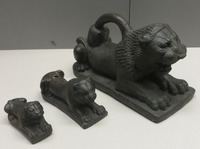Created c. 800–700 BC Identification ME 91220 | Discovered 1845–51 | |
 | ||
Writing Phoenician language and cuneiform Similar Statue of Ashurnasirpal II, Mesha Stele, Black Obelisk of Shalman | ||
The Assyrian lion weights are a group of bronze Mesopotamian weights from the 8th century BCE, with bilingual inscriptions in both cuneiform and Phoenician characters. The lion weights were discovered at Nimrud in the late 1840s and are now in the British Museum.
Contents
The weights date from the 8th century BCE and they have bilingual inscriptions in both cuneiform and Phoenician characters. The Phoenician inscriptions are epigraphically from the same period as the Mesha Stele. They are one of the most important groups of artifacts evidencing the "Aramaic" form of the Phoenician script. At the time of their discovery, they were the oldest Phoenician-style inscription that had been discovered.
Description
The set form a regular series diminishing in size from 30 cm to 2 cm in length. The larger weights have handles cast on to the bodies, and the smaller have rings attached to them. The group of weights also included stone weights in the shape of ducks. The weights represent the earliest known uncontested example of the Aramaic numeral system. Eight of the lions are represented with the only known inscriptions from the short reign of Shalmaneser V. Other similar lion weights were excavated at the Iranian site of Susa in 1901 by the French archaeologist Jacques de Morgan and are now in the Louvre in Paris.
There are two known systems of weights and measures from the ancient Middle East. One system was based on a weight called the mina which could be broken down into sixty smaller weights called shekels. These lion weights, however, come from a different system which was based on the heavy mina which weighed about a kilogram. This system was still being used in the Persian period and is thought to have been used for weighing metals.
Discovery
The weights were discovered by Austen Henry Layard in his earliest excavations at Nimrud (1845–51). A pair of lamassu were found at a gateway, one of which had fallen against the other and had broken into several pieces. After lifting the statue, Layard's team discovered under it sixteen lion weights. The artefacts were first deciphered by Edwin Norris, who confirmed that they had originally been used as weights.
